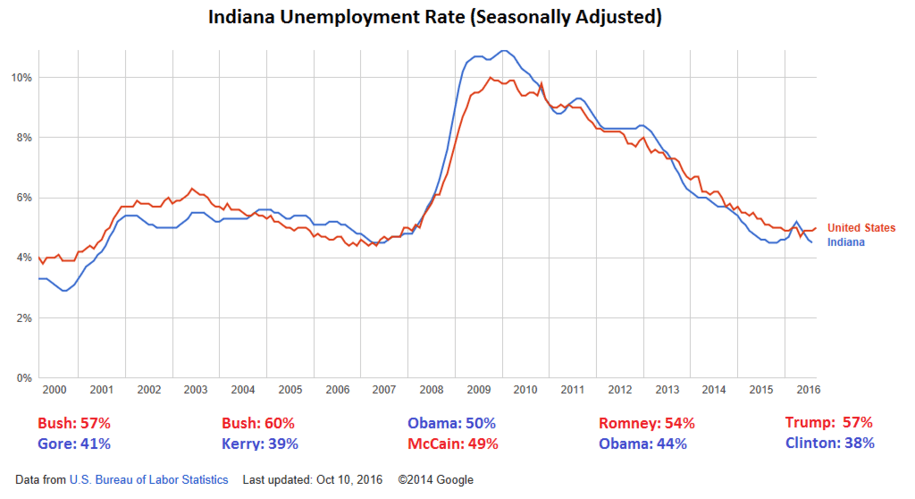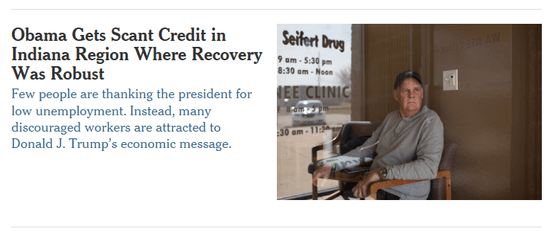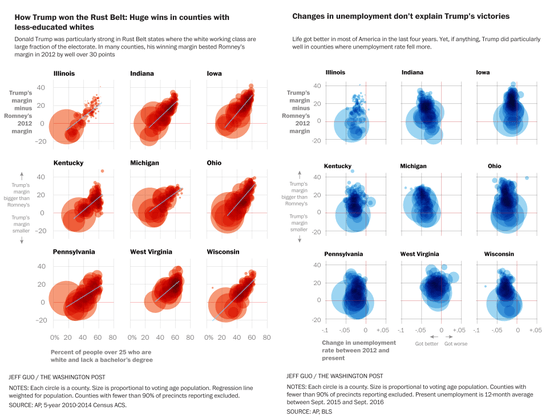Hoosier Daddy? The Man Who Really Delivered the Jobs in Indiana
For much of the past week, President-elect Donald Trump boasted about saving 1,000 jobs at the Carrier air conditioning plant in Indianapolis, Indiana. Representing only about half of the positions candidate Trump promised to protect from relocation to Mexico, the murky Carrier deal appears to be a one-off bargain combining the carrot of state tax breaks with the potential stick of retaliation against the manufacturer's parent company, defense contracting giant United Technologies. For UTX, it was a small price to pay for some favorable PR. For its part, the Obama administration begrudgingly gave credit where credit is due, with press secretary Josh Earnest acknowledging, "This is good news and, obviously, we'd welcome that good news."
As it turns out, the Obama White House has good reason for its lack of enthusiasm. For starters, as economist Justin Wolfers pointed out, "Every savvy CEO will now threaten to ship jobs to Mexico, and demand a payment to stay." And such corporate extortion won't even require a warning to set up shop South of the Border. "You can go to different parts of the United States and then ultimately you'd do full-circle -- you'll come back to Michigan because those guys are going to want their jobs back even if it [their pay] is less," Trump told the Detroit News on August 12, 2015. "We can do the rotation in the United States -- it doesn't have to be in Mexico." But adding insult to injury is the overlooked record of the current occupant of the Oval Office. After all, Barack Obama didn't just preside over the addition of 800,000 new manufacturing jobs since 2010. Thanks to his stimulus program and auto rescue which Donald Trump, Mike Pence and virtually the entire GOP opposed, President Obama deserves much of the credit for the tens of thousands of jobs produced during the economic turnaround of the Hoosier State.
Of course, you'd never know that based on what the good people of Indiana say, or how they vote.

To be sure, Indiana is a traditionally red state. Until Barack Obama narrowly defeated John McCain there in 2008 (see chart at top), Hoosiers voted for Republicans for President in every election since 1964. But eight years ago, Indiana was in desperate need of some hope and change. The great recession that began in late 2007 was hammering the state. By Election Day 2008, the Indiana unemployment rate of 7.6 percent was already well above the national average. On Inauguration Day just two months later, the jobless rate hit 9 percent. The hemorrhaging didn't stop until a year after that, when the unemployment rate peaked at a staggering 10.9 percent.
Then, things started to change for the state that calls itself "the Crossroads of America." Among those "things" was the February 2009 Obama stimulus package, which in addition to tax relief for 95 percent of working Americans brought $8.8 billion in ARRA (American Recovery and Reinvestment Act) funding to Indiana. (Though he opposed the $800 billion program, then Rep. Mike Pence nevertheless requested funds for his district because they would "provide real and long-term economic and livability benefits.") In 2008 and 2009, then Senator and President Barack Obama made four trips to Elkhart, Indiana, to highlight his efforts to reduce an unemployment rate that topped a horrific 20 percent. Then that spring, President Obama followed up on George W. Bush's 2008 loans to Chrysler and GM to launch an $82 billion rescue of the American auto industry. That move, too, was opposed by Donald Trump and his future running mate Mike Pence. As Pence boasted in a 2010 speech in Detroit:
"I even opposed bailing out GM and Chrysler. I welcome the rebound of that company with an open heart, but I still think that most Americans know that it would have still been better for GM and for the country if GM had been allowed to go through normal bankruptcy proceedings."
By 2016, the New York Times reported, the landscape in Indiana had changed dramatically for the better:
Since 2010, the private sector in Indiana has added roughly 300,000 jobs, bringing the unemployment rate from a high of 10.9 percent in January 2010 (nearly a percentage point above the national average) to 4.5 percent now (nearly half a percentage point below the national unemployment rate).
As we'll see below, all of these efforts by the Obama administration in the face of near-total GOP opposition were essential in reversing the fortunes of Hoosier state voters. But in return, by overwhelming margins they delivered Indiana to Republicans Mitt Romney in 2012 and Donald Trump in 2016.

This past April, the New York Times gave a preview of what was to come--and why--in an article titled, "Obama gets scant credit in Indiana region where recovery was robust." Years after the auto bailout and millions of federal stimulus dollars went towards improving local highways, the municipal airport, police equipment and building weatherization, Elkhart County is booming. "Elkhart's unemployment rate, at 3.8 percent, is among the country's lowest," the Times' Jackie Calmes wrote, "so low that employers here in the self-described R.V. capital of the world are advertising elsewhere for workers, offering sign-up bonuses, even hiring from a local homeless shelter." But when it comes to giving credit for that amazing return to prosperity, there is a bipartisan consensus among local officials:
"Whether he gets the credit or not, people's home equity has gone back up, fuel prices are the best we've had in a long time, there's a lot of things that make this all go," Larry Thompson, a former longtime mayor of nearby Nappanee and a Republican, said as he showed off an expanding cabinetry factory, Kountry Wood Products.
"But I think that maybe it's just some of the other things he's been involved with that people in our area" -- Mr. Thompson stopped, shaking his head in unspoken reference to various social issues...
"He gets very, very little credit, and I think that's too bad because we got quite a bit of help," said Dick Moore, Elkhart's mayor the past eight years, a Democrat who lost election to a third term in November. "I don't know what we would have done without it." [Emphasis mine.]
That's exactly right. While the Economic Development Corporation of Elkhart County touts "head of household" job opportunities that pay up to $75,000 a year, Dan Browning of the Faith Mission homeless shelter is fielding dozens of calls each month from companies seeking employees. He no longer deals with businesses offering only minimum wage work. "Now the employers are desperate," he said. "Before it was the workers who were desperate."
But that desperation did not translate into gratitude to--or votes for--either President Obama or his would-have-been Democratic successor, former Secretary of State Hillary Clinton. In 2008, Senator Obama lost Elkhart County by a 55 to 44 percent margin. Four years later, Obama didn't even contest the state, and got drubbed in Elkhart County by 63 to 36 percent. In 2016, Donald Trump expanded on Mitt Romney's numbers, drubbing Clinton by 64 to 32 percent. While manufacturing employment statewide has not returned to its pre-recession levels, some Hoosier State analysts think something else may be behind the rejection of Obama since 2008:
Brian A. Howey, publisher of the Howey Politics Indiana newsletter and once a reporter in Elkhart, sounded stumped, even allowing for the state's conservatism: "I'm a lifelong Hoosier. I'm just amazed that not only do people not appreciate what happened in '09, but there's a lot of hostility toward Obama. I think part of it is racial and a lot of it is political."
"This state stood to lose 150,000 auto jobs if Chrysler and G.M. had liquidated," Mr. Howey added. "We would have had a bona fide depression here." [Emphasis mine.]
A bona fide depression, not just in Indiana, but across the entire United States if not for the federal interventions including the Obama stimulus. As Lori Montgomery of the Washington Post reported in 2012, the nonpartisan Congressional Budget Office (CBO) certainly thought so. Its director, Douglas Elmendorf, explained to Congress that "CBO's own analysis found that the package added as many as 3.3 million jobs to the economy during the second quarter of 2010, and may have prevented the nation from lapsing back into recession." Economists Alan Blinder and Mark Zandi certainly agreed. As their October 2015 showed, the combined federal efforts to rescue the American economy from its greatest collapse since 1929 "dramatically reduced the severity and length of the meltdown that began in 2008; its effects on jobs, unemployment, and budget deficits; and its lasting impact on today's economy." The impact of the measures taken in 2008 and 2009 by Presidents Bush and Obama, including the Troubled Asset Relief Program (TARP), the $800 billion Obama stimulus program, Obama's auto bailout and the Federal Reserve's "quantitative easing," is simply staggering. Without those policy responses--almost all of which were opposed by Congressional Republicans--Blinder and Zandi estimated:
- The peak-to-trough decline in real gross domestic product (GDP), which was barely over 4%, would have been close to a stunning 14%;
- The economy would have contracted for more than three years, more than twice as long as it did;
- More than 17 million jobs would have been lost, about twice the actual number.
- Unemployment would have peaked at just under 16%, rather than the actual 10%;
- The budget deficit would have grown to more than 20 percent of GDP, about double its actual peak of 10 percent, topping off at $2.8 trillion in fiscal 2011.
The decision to rescue GM and Chrysler, derided by Donald Trump, Mike Pence and Mitt Romney, had an outsized impact for Indiana. Ultimately, the federal government spent almost $80 billion to save the two companies. But after selling off its remaining shares, the price tag was much lower at $9.3 billion. But as the Center for Automotive Research documented in December 2013, that sum may have been the best investment Uncle Sam ever made:
Had GM and Chrysler failed altogether, the result could have been 4.1 million jobs lost across the U.S. economy in 2009 and 2010, with federal transfer payments and $105 billion in lost income and payroll tax revenue for the U.S. Treasury.
As the Center's chief economist Sean McAlinden put it, "This peacetime intervention in the private sector by the U.S. government will be viewed as one of the most successful interventions in U.S. economic history."
Especially in Indiana. As the Northwest Indiana Times documented in August 2013, the Obama administration's actions enabled General Motors to rebound from bankruptcy and invest hundreds of millions of dollars in plants and jobs in Fort Wayne. The north central Indiana city of Kokomo came roaring back, as Delphi and Chrysler respectively pumped $190 million and $1.6 billion into facilities there. As the Times' Joseph Pete summed it up, "Indiana's automotive industry has raced ahead to second place nationally and is not letting off the gas."
When domestic automakers begged for federal bailouts and leniency from bankruptcy judges a few years ago, Indiana pulled ahead of Ohio in the total value of automotive products made each year and also took third place away from Kentucky in terms of jobs at automotive assembly plants, according to the U.S. Bureau of Labor Statistics.
The Hoosier state has since held on to second place, producing $9.9 billion in automotive goods compared with Ohio's $6.9 billion in 2011, the most recent year for which data was available. Indiana trails only Michigan, which churned out $18.8 billion in cars and car parts.
On all of this, the Republican ticket of Donald Trump and Mike Pence was silent during the 2016 campaign in the Midwest. They had to be. "Without government financing -- initiated by President George W. Bush in December 2008, the two companies would not have been able to pursue Chapter 11 reorganization," Obama car czar Steven Rattner wrote in 2012. "Instead they would have been forced to cease production, close their doors and lay off virtually all workers once their coffers ran dry." In February 2012, The Economist blasted Mitt Romney--and itself--over the successful rescue of the American auto industry by President Obama:
Free-marketeers that we are, The Economist agreed with Mr Romney at the time. But we later apologised for that position. "Had the government not stepped in, GM might have restructured under normal bankruptcy procedures, without putting public money at risk", we said. But "given the panic that gripped private purse-strings...it is more likely that GM would have been liquidated, sending a cascade of destruction through the supply chain on which its rivals, too, depended." Even Ford, which avoided bankruptcy, feared the industry would collapse if GM went down. At the time that seemed like a real possibility. The credit markets were bone-dry, making the privately financed bankruptcy that Mr Romney favoured improbable. He conveniently ignores this bit of history in claiming to have been right all along.
Unfortunately, the voters of Indiana, along with those in Ohio, Pennsylvania and Michigan, appear to have ignored this bit of history, too. As that series of New York Times features shows, their distrust of Hillary Clinton, of "people who've been here 12 years who don't even care to learn the language but want to reap all the benefits of this country" and of the "status quo" drown out Obama's record and Clinton's platform. As Jeff Guo detailed in the Washington Post, "Yes, working class whites really did make Trump win. No, it wasn't simply economic anxiety."
Certain economic factors were important. Trump tended to outperform Romney in places where median incomes were a little lower, places where people tended to be out of work and where middle-aged whites were more likely to die.
But these places have been like this for a while. In fact, Trump's victory doesn't seem to be linked to any recent declines in people's economic circumstances. The economy has been getting better over the past four years. Median incomes have risen. The unemployment rate has plummeted including in regions won by Trump.
"Trump, on some level, understood the importance of making members of the white working class feel as though they were being heard," Guo concluded, "He tapped into deeper, slower-moving resentments."

But that long-simmering resentment could pale compared to the outrage when these voters learn what Donald Trump and Mike Pence actually have in store for them. Obamacare, which has reduced the uninsured rate in Indiana to a record low, is almost certainly going to get the axe. President Trump will almost certainly break his promises not to touch Medicare and Social Security, as the Republican majority in Congress seems poised to target both. With a national right to work law, a rollback of President Obama's expansion of overtime pay and legal challenges to both private and public sector unions, workers in states Trump turned red may soon see their living standards slashed. Economic growth as high as six percent from "the greatest jobs president god ever created" will be a pipe dream. The draconian tariff barriers Trump promised on China (45 percent) and Mexico (35 percent) almost certainly won't be forthcoming. (If they did, the trade war which would necessarily ensue would boomerang back into the Rust Belt.) Good news though it is, a thousand jobs saved in a dubious deal in Indianapolis will quickly fade from memory.
Back in Indiana, 15-year Carrier employee Nicole Hargrove was among those promising to hold President-elect Trump accountable for his pledge to the air conditioning workers. "If he doesn't pass that tariff, I will vote the other way next time."
Over the next four years, we'll find out who keeps their promises to those Indiana Hoosiers. For the next seven weeks, though, we'll still have someone in the White House who did. As he often said half-jokingly on the campaign trail this year, "We avoided a Great Depression. Thanks, Obama."

